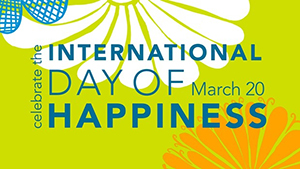Today is the United Nations International Day of Happiness and in countries all over the world people are being asked to help create more happiness in the world around them by focusing on their connections with other people.
It is true that there is lots of scientific evidence to support the idea that having good solid relationships in your life will help with your own personal  happiness rating, however that is only part of the story. Shawn Anchor, psychologist at Harvard and author of ‘The Happiness Advantage’ says,
happiness rating, however that is only part of the story. Shawn Anchor, psychologist at Harvard and author of ‘The Happiness Advantage’ says,
“What’s going on in your life — from health, to money, to relationships, to prestige — predicts only about 10% of your happiness”
His fundamental principal is that you don’t get happy by achieving success. You achieve success by getting happy.
So that’s an easy enough principle to get your head around, but what do we actually need to do about it? The internet is jam packed with array of commentaries, handy tips and pearls of wisdom on the subject of achieving happiness and loads of practical advice on how to go about it.
Included in many of these will be things such as ‘expressing more gratitude for the good things in life’, ‘taking more exercise’ and ‘setting positive goals’. All of these things are hugely valuable in the journey towards greater happiness but none of them on their own necessitates a change in mindset. In fact, if they are merely added to the great ‘to do’ list could even end having the opposite effect and making you feel less happy.
A change in perspective can often work wonders and when you need to see things from a different angle it’s often helpful to think about how children respond to the world around them.
When a child looks out of the window and see’s it is raining they think “brilliant, it’s raining, I can put my wellies on, go and jump in puddles and get drenched”. An adult on the other hand, will more like think “well that’s put a downer on things. I was looking forward to going out but now I will have to stay in and no doubt the kids will be climbing the walls”. In other words, children find the joy in things. It’s their default response.
Secondly, think about what a child would say if asked “what would you like to do today?” For a child, that question opens up a blank canvas that they can fill entirely with fun. Endless possibilities present themselves of creating things, playing games and sport, visiting the park or the beach, riding a bike, the list is endless. Not so in the adult mind. We are far more likely to fill our blank canvas with obligations and duties, “I must do the supermarket shop, go to the gym (to get fit and not to have fun), sort out the spare room, weed the front lawn and so it goes on.
Not that there is anything wrong with getting through our ‘to do’ list, in fact the satisfaction of ticking things off can bring enormous rewards. However what we need remember is that fun doesn’t just happen, we need to plan for it. It’s up to us to make it happen.
So in your quest to get happy, I urge you to see the world through the eyes of a child. Work hard on finding the joy in everyday things and make it your mission to plan for fun!
For more invaluable insights in How to Get Happy, download our free ‘Seven Steps to Happiness – your ultimate guide” right here.












